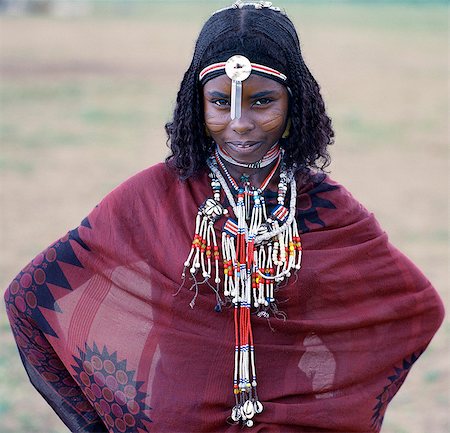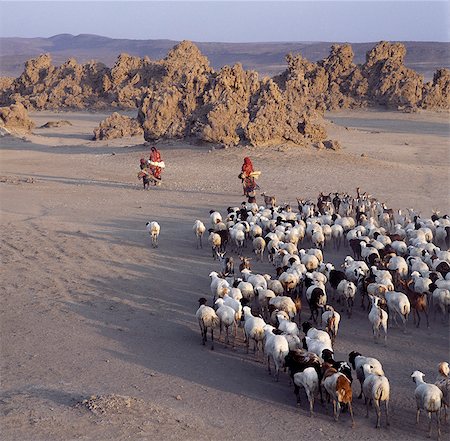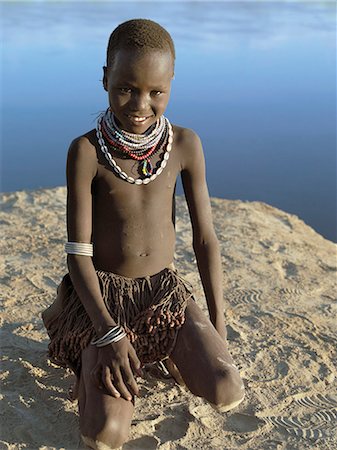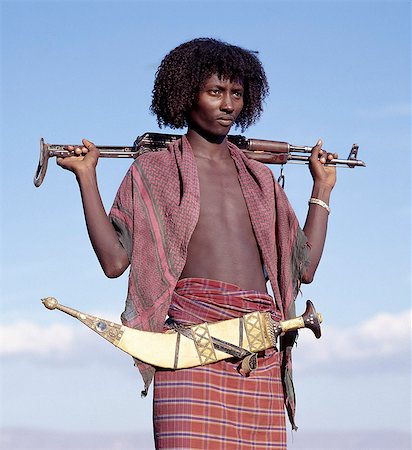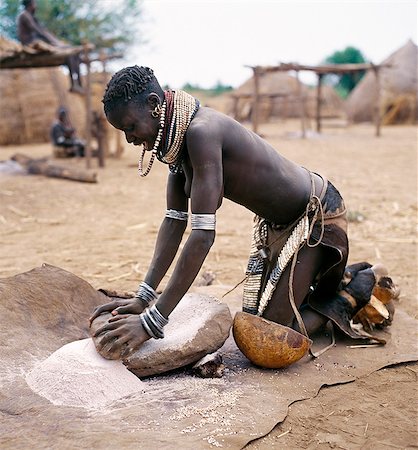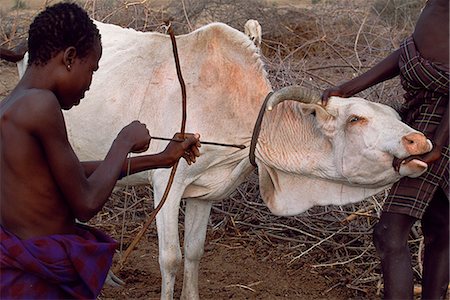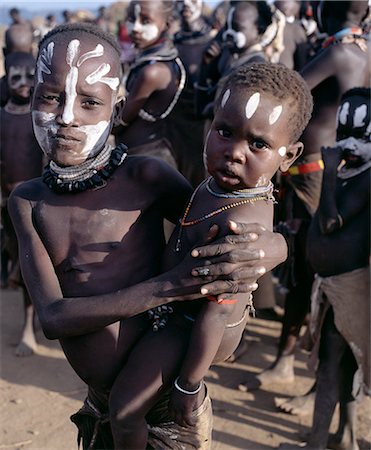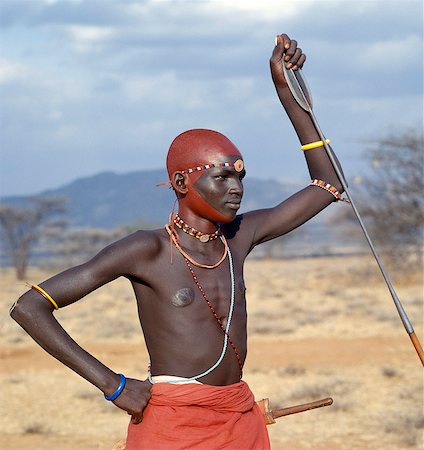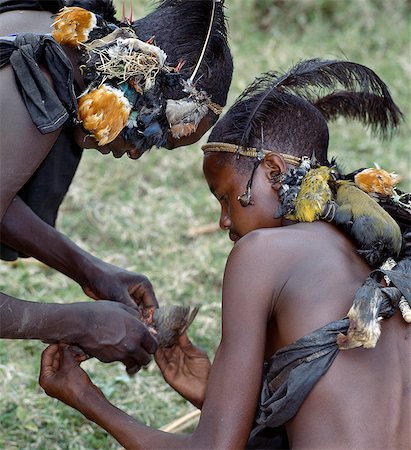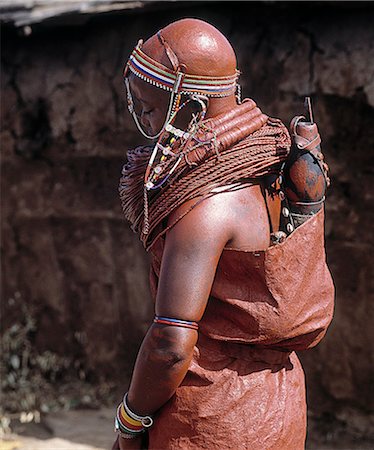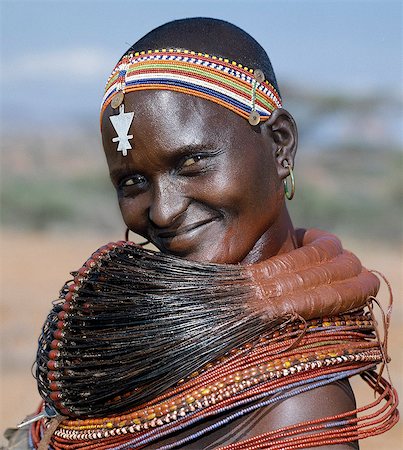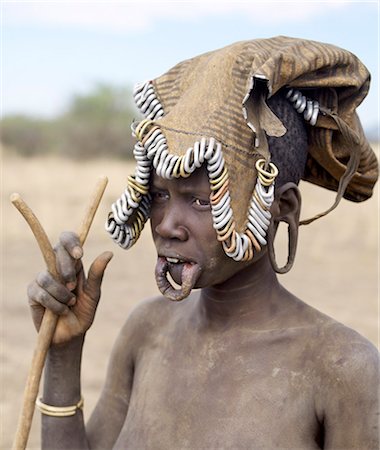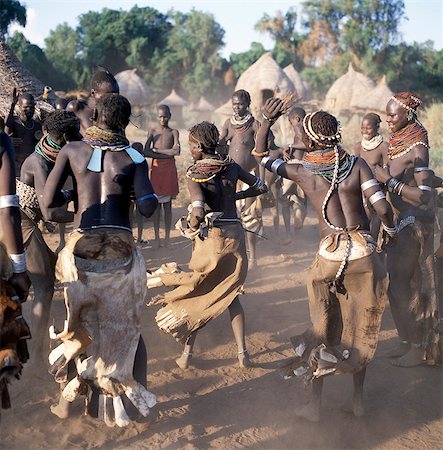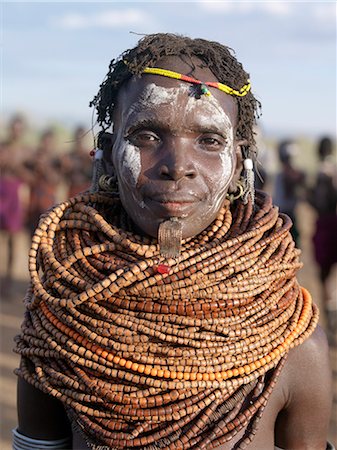-
A pretty tousle-haired girl of the nomadic Afar tribe wears bright colours in stark contrast to the drab,windswept surroundings of Lake Abbe.
Rights-Managed
-
The fetching hairstyle of a young Afar girl. Proud and fiercely independent,the nomadic Afar people live in the low-lying deserts of Eastern Ethiopia.
Rights-Managed
-
A young Afar girl at Filwoha in the Awash National Park. Filwoha in the Afar language means 'hot water'. The beautiful springs are surrounded by doum palms and rise from deep underground at about 96.8 degrees F.
Rights-Managed
-
An Afar woman adjusts the load on her camel as her young child sits on top. Proud and fiercely independent,the nomadic Afar people live in the low-lying deserts of Eastern Ethiopia. Camels are valuable in these harsh conditions; they carry house structures and personal possessions,enabling families to follow the seasonal pattern of rain and grazing.
Rights-Managed
-
An Afar girl with braided hair has very noticeable scarification on her cheeks. Scarification is practiced in only a few sections of her tribe. Proud and fiercely independent,the nomadic Afar people live in the low-lying deserts of Eastern Ethiopia.
Rights-Managed
-
An Afar girl has her attractive hairstyle embellished with buttons and beads,which is typical of the young girls of her tribe. Proud and fiercely independent,the nomadic Afar people live in the low-lying deserts of Eastern Ethiopia.
Rights-Managed
-
An Afar camel caravan crosses the salt flats of Lake Assal, Djibouti, as shadows lengthen in the late afternoon sun. At 509 feet below sea level, Lake Assal is the lowest place in Africa.Extremely high midday temperatures, which can surpass 120 Fahrenheit.The salt is sold across the border in Ethiopia.
Rights-Managed
-
An Afar camel caravan crosses the salt flats of Lake Assal, Djibouti, as shadows lengthen in the late afternoon sun. At 509 feet below sea level, Lake Assal is the lowest place in Africa.Extremely high midday temperatures, which can surpass 120 Fahrenheit.The salt is sold across the border in Ethiopia.
Rights-Managed
-
An Afar camel caravan crosses the salt flats of Lake Assal, Djibouti, as shadows lengthen in the late afternoon sun. At 509 feet below sea level, Lake Assal is the lowest place in Africa.Extremely high midday temperatures, which can surpass 120 Fahrenheit.The salt is sold across the border in Ethiopia.
Rights-Managed
-
An Afar camel caravan crosses the salt flats of Lake Assal, Djibouti, as shadows lengthen in the late afternoon sun. At 509 feet below sea level, Lake Assal is the lowest place in Africa.Extremely high midday temperatures, which can surpass 120 Fahrenheit.The salt is sold across the border in Ethiopia.
Rights-Managed
-
An Afar settlement and livestock close to the Awash National Park. The mountain in the distance is Fantale,a dormant volcano with a large crater from which steam still issues from vents. The most recent lava flow dates back to 1820.
Rights-Managed
-
An Afar girl has tribal scarification on her cheeks. Scarification is practiced in only a few sections of her tribe. Proud and fiercely independent,the nomadic Afar people live in the low-lying deserts of Eastern Ethiopia.
Rights-Managed
-
Warriors of the nomadic Afar tribe carry large curved daggers, known as jile, strapped to their waists.Proud and fiercely independent, they live in the low lying deserts of Eastern Ethiopia.
Rights-Managed
-
Lake Abbe, on the border of Djibouti and Ethiopia, is the last in a line of alkaline lakes in which the Awash River dissipates.Livestock belonging to the nomadic Afar people graze this harsh, windswept region.
Rights-Managed
-
Lake Abbe, on the border of Djibouti and Ethiopia, is the last in a line of alkaline lakes in which the Awash River dissipates. Livestock belonging to the nomadic Afar people graze this harsh, windswept region.
Rights-Managed
-
Lake Abbe, on the border of Djibouti and Ethiopia, is the last in a line of alkaline lakes in which the Awash River dissipates. The jagged pinnacles and spires close to the lake were formed thousands of years ago when volcanic gases bubbled up through the bottom of an ancient lake that was 100 feet deeper than it is today.Livestock belonging to the nomadic Afar people graze this harsh, windswept r
Rights-Managed
-
Lake Abbe, on the border of Djibouti and Ethiopia, is the last in a line of alkaline lakes in which the Awash River dissipates. The jagged pinnacles and spires close to the lake were formed thousands of years ago when volcanic gases bubbled up through the bottom of an ancient lake that was 100 feet deeper than it is today.Livestock belonging to the nomadic Afar people graze this harsh, windswept r
Rights-Managed
-
As the light fades on a blistering day, an Afar man digs for salt at Lake Assal.At 509 feet below sea level, Lake Assal is the lowest place in Africa.Nomadic Afar tribesmen come here with their camels to collect salt.The camel caravans leave again before daybreak the following day.Each animal carries between four and ten thirty pound sacks according to its size and maturity.The salt is sold across
Rights-Managed
-
At 509 feet below sea level, Lake Assal is the lowest place in Africa.Thousands of years ago, the lake level was much higher as evidenced by the watermark on the hills. Nomadic Afar tribesmen come here with their camels to collect salt.The salt is sold across the border in Ethiopia.
Rights-Managed
-
Lake Abbe, on the border of Djibouti and Ethiopia, is the last in a line of alkaline lakes in which the Awash River dissipates. Livestock belonging to the nomadic Afar people graze this harsh, windswept region.
Rights-Managed
-
A young Dorze boy winds cotton onto a bobin for his father. Dorze men are synonymous with weaving the best cotton cloth in Ethiopia.
Rights-Managed
-
A young Nyangatom girl on the banks of the Omo River.The Nyangatom are one of the largest tribes and arguably the most warlike people living along the Omo River in Southwest Ethiopia. They form a part of the Ateger speaking people a cluster of seven eastern Nilotic tribes to which the Turkana of Northern Kenya and the Karamajong of Eastern Uganda belong.
Rights-Managed
-
Warriors of the nomadic Afar tribe wear their hair long and carry large curved daggers, known as jile, strapped to their waists.Proud and fiercely independent, they live in the low lying deserts of Eastern Ethiopia.Modern rifles have now replaced daggers as weapons although most young men still wear ornate daggers by tradition.
Rights-Managed
-
Warriors of the nomadic Afar tribe wear their hair long and carry large curved daggers, known as jile, strapped to their waists.Proud and fiercely independent, they live in the low lying deserts of Eastern Ethiopia.Modern rifles have now replaced daggers as weapons although most young men still wear ornate daggers by tradition.
Rights-Managed
-
Lake Abbe, on the border of Djibouti and Ethiopia, is the last in a line of alkaline lakes in which the Awash River dissipates.Livestock belonging to the nomadic Afar people graze this harsh, windswept region.
Rights-Managed
-
Lake Abbe, on the border of Djibouti and Ethiopia, is the last in a line of alkaline lakes in which the Awash River dissipates.Livestock belonging to the nomadic Afar people graze this harsh, windswept region.
Rights-Managed
-
A Nyangatom mother and young daughter in typical dress. Rugged skin clothing is still widely used.The Nyangatom are one of the largest tribes and arguably the most warlike people living along the Omo River in Southwest Ethiopia.
Rights-Managed
-
A Nyangatom woman grinds sorghum using a flat stone.The Nyangatom are one of the largest tribes and arguably the most warlike people living along the Omo River in Southwest Ethiopia.They form a part of the Ateger speaking people a cluster of seven eastern Nilotic tribes to which the Turkana of Northern Kenya and the Karamajong of Eastern Uganda belong.
Rights-Managed
-
A Nyangatom woman dries sorghum and other corn in the vicinity of her elevated grain stores, which prevent loss when the Omo River bursts its banks.The Nyangatom are one of the largest tribes and arguably the most warlike people living along the Omo River in Southwest Ethiopia.
Rights-Managed
-
A pregnant Nyangatom woman in traditional attire outside her neatly thatched home.The Nyangatom are one of the largest tribes and arguably the most warlike people living along the Omo River in Southwest Ethiopia.
Rights-Managed
-
A Nyangatom woman milks her familys cows early in the morning. It is the sole responsibility of women and children to milk cows, Nyangatom men will never do so.The Nyangatom are one of the largest tribes and arguably the most warlike people living along the Omo River in Southwest Ethiopia.
Rights-Managed
-
A Karo woman with her face painted in preparation for a dance in the village of Duss. A small Omotic tribe related to the Hamar, who live along the banks of the Omo River in southwestern Ethiopia, the Karo are renowned for their elaborate body painting using white chalk, crushed rock and other natural pigments. She is wearing a goatskin apron and carries a leather belt decorated with cowrie shells
Rights-Managed
-
A Karo women stands in the doorway to her hut in the village of Duss. A small Omotic tribe related to the Hamar, who live along the banks of the Omo River in southwestern Ethiopia, the Karo are renowned for their elaborate body painting using white chalk, crushed rock and other natural pigments. In addition to painting her face she has decorated her body with whorls of goat hair tied by leather co
Rights-Managed
-
A young Nyangatom woman carries her baby on her hip in an elaborately braided papoose. Her hair has been reddened with a mixture of ochre and animal fat. Typical of her tribe, she wears a calfskin skirt, multiple layers of bead necklaces and metal bracelets and amulets. The Nyangatom or Bume are a Nilotic tribe of semi nomadic pastoralists who live along the banks of the Omo River in south western
Rights-Managed
-
A Nyangatom boy holds a cow whilst another boy draws his bow ready to fire an arrow with a very short head into the artery of the cow so they can bleed it. Several pints of blood will be collected which will then be mixed with milk and drunk by the Nyangatom. The Nyangatom or Bume are a Nilotic tribe of sem nomadic pastoralists who live along the banks of the Omo River in south western Ethiopia.
Rights-Managed
-
A Nyangatom boy holds a cow whilst another boy draws his bow ready to fire an arrow with a very short head into the artery of the cow so they can bleed it. Several pints of blood will be collected which will then be mixed with milk and drunk by the Nyangatom. The Nyangatom or Bume are a Nilotic tribe of sem nomadic pastoralists who live along the banks of the Omo River in south western Ethiopia.
Rights-Managed
-
A Nyangatom woman wears multiple layers of beads in necklaces, an elaborately beaded calfskin skirt and metal bracelets, amulets and anklets. She is standing beside a temporary beehive construction of sticks, grass and leaves built to provide shade for her goats. The Nyangatom or Bume are a Nilotic tribe of semi-nomadic pastoralists who live along the banks of the Omo River in south western Ethio
Rights-Managed
-
A Nyangatom woman stands with her baby on her hip beside her grass hut in his temporary camp. Nyangatom married women wear elaborately beaded skirts which reach the ground at the back and often have panels of different coloured calkfskin sewn into the tail The Nyangatom or Bume are a Nilotic tribe of semi nomadic pastoralists who live along the banks of the Omo River in south western Ethiopia.
Rights-Managed
-
Two Mursi men with singular hairstyles play a game of bau as a young boy watches them. Most men possess rifles to protect their families from hostile neighbours.Body art is an important aspect of Mursi culture.They live in a remote area of southwest Ethiopia along the Omo River.
Rights-Managed
-
A Mursi woman wearing a large clay lip plate. Shortly before marriage, a girls lower lip will be pierced and progressively stretched over a year or so. The size of the lip plate often determines the quantum of the bride price. They live in a remote area of southwest Ethiopia along the Omo River, the country's largest river.
Rights-Managed
-
A Mursi woman wearing a large wooden lip plate. Shortly before marriage, a girls lower lip will be pierced and progressively stretched over a year or so. The size of the lip plate often determines the quantum of the bride price. They live in a remote area of southwest Ethiopia along the Omo River.
Rights-Managed
-
Shaded from the hot sun, a Karo woman grinds sorghum using large flat stones.It is customary for females of the tribe when in their teens to make a small hole in the flesh below their lower lips into which they put an ornament, this woman has used a small nail. Numerous heavy metal bracelets are worn by married womenThe Karo are a small tribe living in three main villages along the lower reaches o
Rights-Managed
-
The Karo of the Lower Omo River excel in body art. They decorate their faces and torsos elaborately using local white chalk, pulverised rock and other natural pigments. Even young children daub their faces before a dance.The Karo are a small tribe living in three main villages along the lower reaches of the Omo River in southwest Ethiopia.
Rights-Managed
-
Black clothing and the intricate white patterns on the face of this Maasai youth of the Kisongo section signify his recent circumcision.
Rights-Managed
-
Black clothing,Black ostrich feathers and the intricate white patterns on the face of this Maasai youth of the Kisongo section signify his recent circumcision.
Rights-Managed
-
A Karo woman sits with child. A small Omotic tribe related to the Hamar,who live along the banks of the Omo River in southwestern Ethiopia,the Karo are renowned for their elaborate body painting using white chalk,crushed rock and other natural pigments. Typically for a Karo woman,the mother has ochred her hair in tight ringlets and has a ring through her bottom lip.
Rights-Managed
-
An elder of the Karo tribe sits with his wife and child. A small Omotic tribe related to the Hamar,who live along the banks of the Omo River in southwestern Ethiopia,the Karo are renowned for their elaborate body painting using white chalk,crushed rock and other natural pigments. This man also has a clay hairdo typical of tribal elders. Like most adult males he carries a rifle.
Rights-Managed
-
A Dassanech woman milks a cow by hand collecting the milk in a gourd at a settlement alongside the Omo River. Much the largest of the tribes in the Omo Valley numbering around 50,000,the Dassanech (also known as the Galeb,Changila or Merille) are Nilotic pastoralists and agriculturalists.
Rights-Managed
-
A young Dassanech girl holds her little brother. She wears a leather skirt with an elaborate fringe of wooden and metal tassles. Much the largest of the tribes in the Omo Valley numbering around 50,000,the Dassanech (also known as the Galeb,Changila or Merille) are Nilotic pastoralists and agriculturalists.
Rights-Managed
-
A young Dassanech girl holds her little brother. She wears a leather skirt with an elaborate fringe of wooden and metal tassles. Much the largest of the tribes in the Omo Valley numbering around 50,000,the Dassanech (also known as the Galeb,Changila or Merille) are Nilotic pastoralists and agriculturalists.
Rights-Managed
-
A Nyangatom woman grinds sorghum using two stones. Typical of her tribe,she wears a heavily beaded calfskin skirt,multiple layers of bead necklaces and metal bracelets and amulets. The Nyangatom or Bume are a Nilotic tribe of semi-nomadic pastoralists who live along the banks of the Omo River in south-western Ethiopia.
Rights-Managed
-
A Nyangatom boy catches blood from the artery of a cow in a gourd. The cow is bled by firing an arrow with a very short head into the artery of the cow. Several pints of blood will be collected which will then be mixed with milk and drunk by the Nyangatom. The Nyangatom or Bume are a Nilotic tribe of semi-nomadic pastoralists who live along the banks of the Omo River in south-western Ethiopia.
Rights-Managed
-
A Nyangatom girl churns butter in a gourd suspended in the entrance to her hut. Typical of her tribe,she is wearing multiple layers of beads in necklaces,and an elaborately beaded calfskin skirt. The Nyangatom or Bume are a Nilotic tribe of semi-nomadic pastoralists who live along the banks of the Omo River in south-western Ethiopia.
Rights-Managed
-
A Dassanech man poles a dug-out canoe across the muddy waters of a tributary of the Omo River in its delta near Lake Turkana. The Omo has one of the largest inland deltas in the world and is home to a large section of Dassanech people who speak a language of Eastern Cushitic origin.
Rights-Managed
-
Kenya, Samburu District. A Samburu woman, wearing intricate beaded necklaces, leans against her mud hut towards the end of the day.
Rights-Managed
-
Lake Abbe, on the border of Djibouti and Ethiopia, is the last in a line of alkaline lakes in which the Awash River dissipates. Livestock belonging to the nomadic Afar people graze this harsh, windswept region.
Rights-Managed
-
A young Maasai herdsboy controls his family's cattle at the Sanjan River to prevent too many animals watering at the same time.
Rights-Managed
-
Two young Datoga men work wells on the east side of Lake Manyara to water their family's livestock. The man who draws water balances precariously on two poles.The Datoga (known to their Maasai neighbours as the Mang'ati and to the Iraqw as Babaraig) live in northern Tanzania and are primarily pastoralists.
Rights-Managed
-
A young Maasai girl wears a headband decorated with chains and cowrie shells that signifies her recent circumcision. Clitodectomy was commonly practiced by the Maasai but it is now gradually dying out.
Rights-Managed
-
A Dassanech girl braids her sister's hair at her village in the Omo Delta. Much the largest of the tribes in the Omo Valley numbering around 50,000,the Dassanech (also known as the Galeb,Changila or Merille) and Nilotic pastoralists and agriculturalists.
Rights-Managed
-
Karo men paint each other in preparation for a dance in the village of Duss. A small Omotic tribe related to the Hamar,who live along the banks of the Omo River in southwestern Ethiopia,the Karo are renowned for their elaborate body painting using white chalk,crushed rock and other natural pigments.
Rights-Managed
-
An elder of the Karo tribe,a small Omotic tribe related to the Hamar,who live along the banks of the Omo River in southwestern Ethiopia. The Karo are renowned for their elaborate body painting using white chalk,crushed rock and other natural pigments. This man also has a clay hairdo typical of tribal elders. Like most adult males he carries a rifle.
Rights-Managed
-
A Nyangatom girl weaves a grass basket. The Nyangatom or Bume are a Nilotic tribe of semi-nomadic pastoralists who live along the banks of the Omo River in south-western Ethiopia.
Rights-Managed
-
A smart young Hamar youth at Turmi Market.The Hamar are semi-nomadic pastoralists who live in harsh country around the Hamar Mountains of Southwest Ethiopia. Their whole way of life is based on the needs of their livestock. Cattle are economically and culturally their most important asset.
Rights-Managed
-
A Datoga baby is carried in a leather carrier on his mothers back The traditional attire of Datoga women includes beautifully tanned and decorated leather dresses and coiled brass ornaments of every description.
Rights-Managed
-
Niger, Tenere Desert.Camel Caravan travelling through the Air Mountains.This is the largest protected area in Africa, covering over 7.7 million hectares.
Rights-Managed
-
An old Turkana woman wearing all the finery of her tribe.In a hole pierced below her lower lip, she wears an ornament beautifully made from twisted strands of copper wire.Leaf shaped ear ornaments are typically worn by married women of the tribe and the tiny amber coloured rings hanging from her earrings are made from goats hooves.
Rights-Managed
-
Kenya, Samburu District, Wamba.Immediately an initiate completes his lmuget loolbaa ceremony a month after his circumcision, he becomes a junior warrior of the Samburu tribe. From wearing a drab black cloak and carrying a bow and arrows, he proudly dons the ochred finery of a warrior, spear in hand. Overnight, he is transformed from a boy into a man, confident of his new role in tribal affairs.
Rights-Managed
-
Samburu initiates sing during the month after their circumcision. As their wounds heal, their dances become more energetic. Before long, they imitate the dances of the warriors which, hitherto, they have been forbidden to perform.They spend much of their time wandering in the countryside attempting to kill as many birds as they can with a club and four blunt arrows. When a bird is killed, it is sk
Rights-Managed
-
Samburu initiates skin a bird without the use of a knife.While their wounds heal for a month after circumcision, initiates spend their time wandering in the countryside attempting to kill as many birds as they can with a club and four blunt arrows. When a bird is killed, it is skinned, stuffed with dry grass and attached to the boy's headband by means of its beak.
Rights-Managed
-
A Samburu initiate takes aim at a bird with a blunt arrow.While their wounds heal for a month after circumcision, initiates spend their time wandering in the countryside attempting to kill as many birds as they can with a club and four blunt arrows. When a bird is killed, it is skinned without a knife, stuffed with dry grass and attached to the boys headband by means of its beak.
Rights-Managed
-
Kenya, South Horr, Kurungu.A Samburu youth after his circumcision. The day after he has been circumcised, the initiate must hang in his pierced earlobes copper ear ornaments that are normally worn by married women. His sponsors make him a new headdress of ostrich feathers fastened to a narrow band of plaited fibre, which fits tightly round his forehead like a sweatband.
Rights-Managed
-
A Samburu mother shaves her sons head outside her home the day before he is circumcised.Round her neck hangs his nchipi, the distinctive decoration of every boy who participates in the circumcision ritual. The strings of blue beads terminate in large bronze coloured wings of a torpedo shaped beetle, Sterocera hildebrandti.
Rights-Managed
-
A Samburu boy the day before his circumcision.He has daubed the right side of his face and body with white clay while drawing water from a source that never dries up. Each boy will carry for this purpose a new gourd shaped container made by his mother from hollowed out wood.
Rights-Managed
-
In the weeks leading up to their circumcision, Samburu boys must wear charcoal-blackened cloaks, which are made from three goatskins by their mothers.They also style their hair in a tuft at the back of their skulls.The elders of the tribe harangue them frequently.Uncircumcised boys are considered children whatever their age.
Rights-Managed
-
A Samburu bride waits pensively outside her new home until she is enticed in with promises of cattle.Her wedding gown is made of three goatskins, which are well oiled and covered in red ochre.She carries on her back a gourd full of milk and a small wooden jar containing butter.She now wears the mporro necklace of married women.
Rights-Managed
-
A month after a Samburu youth has been circumcised, he becomes a warrior.He will go to the nearest stream or Waterhole to wash off a months grime.He then decorates himself with a mixture of ochre and animal fat, and adorns himself with beads. The sudden change in his appearance is remarkable.
Rights-Managed
-
A Samburu boy in reflective mood after his circumcision.A day after the ordeal, he will hang in his pierced earlobes copper earrings normally worn by married women and put on a new headdress of ostrich feathers fastened to a narrow band of plaited fibre, which fits tightly round his forehead.
Rights-Managed
-
A Samburu woman wearing a mporro necklace, which denotes her married status. These necklaces were once made of hair from giraffe tails but nowadays, the fibres of doum palm fronds, Hyphaene coriacea, are used instead.The red beads after which the necklace is named are wound glass beads made in Venice c.1850.
Rights-Managed
-
A Samburu woman wearing a mporro necklace, which denotes her married status. These necklaces were once made of hair from giraffe tails but nowadays, the fibres of doum palm fronds, Hyphaene coriacea, are used instead.The red beads after which the necklace is named are wound glass beads made in Venice c.1850.
Rights-Managed
-
A Samburu woman wearing a mporro necklace, which denotes her married status. These necklaces were once made of hair from giraffe tails but nowadays, the fibres of doum palm fronds, Hyphaene coriacea, are used instead.The red beads after which the necklace is named are wound glass beads made in Venice c.1850.
Rights-Managed
-
A Mursi woman wearing a large clay lip plate and ear ornaments to match.Shortly before marriage, a girls lower lip will be pierced and progressively stretched over a year or so while some of her teeth will be removed for the plate to fit snugly. The size of the lip plate often determines the quantum of the bride price. The reason for this singular practice is not fully understood but Mursi women
Rights-Managed
-
A Mursi woman wearing a large clay lip plate and ear ornaments to match.Shortly before marriage, a girls lower lip will be pierced and progressively stretched over a year or so while some of her teeth will be removed for the plate to fit snugly.The size of the lip plate often determines the quantum of the bride price. The reason for this singular practice is not fully understood but Mursi women
Rights-Managed
-
A Mursi woman wearing a large clay lip plate and ear ornaments to match.Shortly before marriage, a girls lower lip will be pierced and progressively stretched over a year or so while some of her teeth will be removed for the plate to fit snugly.The size of the lip plate often determines the quantum of the bride price. The reason for this singular practice is not fully understood but Mursi women
Rights-Managed
-
A Mursi woman wearing a large clay lip plate and ear ornaments to match.Shortly before marriage, a girls lower lip will be pierced and progressively stretched over a year or so while some of her teeth will be removed for the plate to fit snugly.The size of the lip plate often determines the quantum of the bride price. The reason for this singular practice is not fully understood but Mursi women
Rights-Managed
-
A Mursi woman wearing a large clay lip plate and ear ornaments to match.Shortly before marriage, a girls lower lip will be pierced and progressively stretched over a year or so while some of her teeth will be removed for the plate to fit snugly. The size of the lip plate often determines the quantum of the bride price. The reason for this singular practice is not fully understood but Mursi women
Rights-Managed
-
A Mursi woman with decorated face and body scarification wears a large clay lip plate. Shortly before marriage, a girls lower lip will be pierced and progressively stretched over a year or so while some of her teeth will be removed for the plate to fit snugly.The size of the lip plate often determines the quantum of the bride price.The reason for this singular practice is not fully understood but
Rights-Managed
-
A lively Nyangatom dance is enjoyed by villagers in the late afternoon.The elevated houses in the background are both homes and granaries, which have been built to withstand flooding when the Omo River bursts its banks The Nyangatom are one of the largest tribes and arguably the most warlike people living along the Omo River in Southwest Ethiopia.
Rights-Managed
-
A Nyangatom woman wears numerous strands of beads made from wood.The Nyangatom are one of the largest tribes and arguably the most warlike people living along the Omo River in Southwest Ethiopia. They form a part of the Ateger speaking people a cluster of seven eastern Nilotic tribes to which the Turkana of Northern Kenya and the Karamajong of Eastern Uganda belong.
Rights-Managed
-
A Nyangatom woman wears numerous strands of beads made from wood.The Nyangatom are one of the largest tribes and arguably the most warlike people living along the Omo River in Southwest Ethiopia. They form a part of the Ateger speaking people a cluster of seven eastern Nilotic tribes to which the Turkana of Northern Kenya and the Karamajong of Eastern Uganda belong.
Rights-Managed




